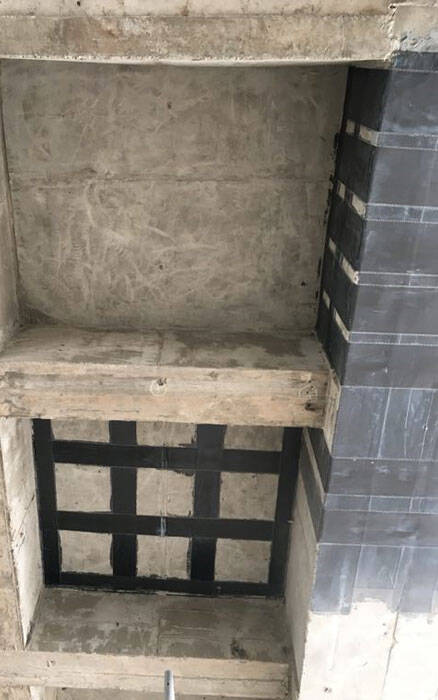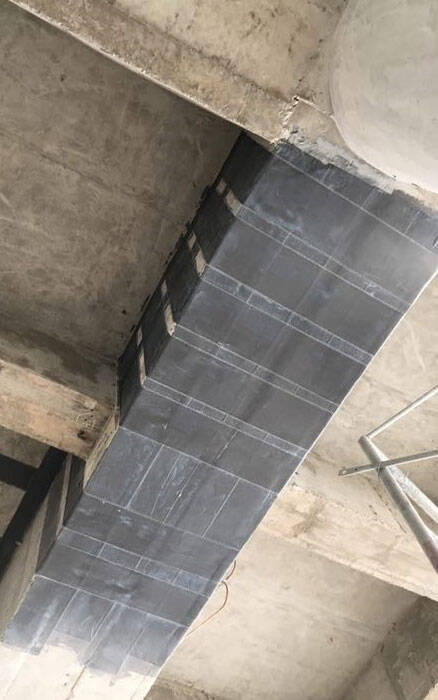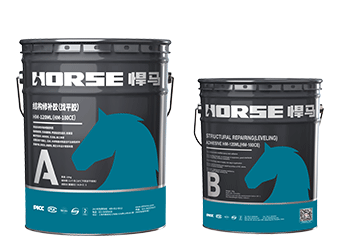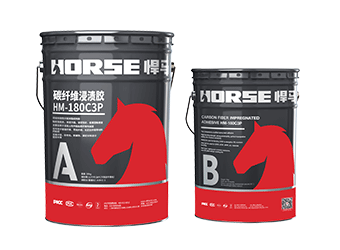Soluciones
La gama de negocios de construcción de caballos se extiende a todo el mundo y sirve a miles de clientes con productos, orientación técnica especializada en construcción, y somos testigos del reinicio de la marca china con ellos.
Carbon fiber fabric is suitable for reinforcement and repair of various structural types and parts, such as beams, slabs, columns, roof trusses, piers, bridges, cylinders, shells and other structures. The strength grade of base concrete is not less than C15, and CFRP fabric has been successfully used in various beam and slab reinforcement and maintenance in China.

Common problems of beam slab bearing structure
The main reason for the insufficient bearing capacity of bending members such as beams and slabs is the inconsistency of force calculation, or the omission or miscalculation of calculation load. Serious overloading may also lead to inadequate bearing capacity of the beam and slab, because the concrete strength can not meet the design requirements during the construction process, or due to the inappropriate reinforcement, resulting in inadequate flexural capacity of the beam and slab. In addition, the settlement of the foundation due to some other reasons produces some additional stress, in dealing with this stress using some inappropriate devices, but has a negative impact on the beam and slab. For example, if a thin web beam is added to the beam slab during stress treatment, although the effect of stress can be balanced and the dead weight can be increased, some thin web beams will appear oblique cracks, resulting in corrosion of beam slab components, durability is greatly affected, serious cases may lead to beam slab fracture, affecting the bearing capacity of the beam slab. Some of the reasons for this are anchorage lapping length or load changes. The main purpose of beam-slab reinforcement is to reinforce and improve the strength, stability, stiffness and durability of the members.
Beam slab structure reinforcement
There are great differences in mechanical properties between the strengthened and unreinforced beam-slab structures. One is that the reinforcement structure is equivalent to secondary treatment and secondary force, and the structure must be subjected to secondary force on the basis of the original force. The original structure may be deformed and bended. In addition, the original load is not unloaded, which is equivalent to secondary compression. There is a difference between the new partial stress and the original structural load stress. When the two stresses reach the peak value at the same time, the failure force reaches the limit state. Therefore, the above problems must be faced when strengthening beams and slabs. There is also the reinforcement of the new part and the old part of their own work as a whole is different, in the calculation of stress and structural treatment are quite different, so beam-slab reinforcement is different from ordinary concrete structure engineering. Therefore, carbon fiber fabric reinforcement technology should be introduced to improve the strengthening of concrete beams and slabs.
Process and characteristics of carbon fiber fabric reinforcement
It is suitable for reinforcement and repair of various structural types and parts, such as beams, slabs, columns, roof trusses, piers, bridges, cylinders, shells and other structures. The strength grade of base concrete is not less than C15, and CFRP fabric has been successfully used in various beam and slab reinforcement and maintenance in China.
In 2014, after Haimen Daxin Bridge tried to reinforce the bridge with bonded steel plates, Haimen Linjiang Gate Bridge first attempted to reinforce the bridge with bonded and wrapped CFRP fabric. This is the first time that the construction technology of the bridge is repaired and strengthened in Haimen. Carbon fiber fabric reinforcement can quickly reinforce the bridge, prevent the external moisture from entering the concrete cracks causing corrosion to the steel bar, ensure the durability of the components, help to improve the bearing capacity of the bridge, and do not affect the normal operation of the bridge during the reinforcement. Linjiang Gate Bridge invested 350,000 yuan. Highway departments carried out a comprehensive maintenance of the existing defects of Linjiang Gate Bridge, adding 4,000 kg of reinforcing steel bar with expansion joints, pasting 500 M2 carbon fiber fabric on the arch foot of the bridge, and polymer grouting 500 m2. Through the maintenance of trunk highway and bridge, all kinds of hidden dangers are eliminated in time, the technical status of trunk highway and Bridge in Haimen is effectively improved, and the safety and unimpeded of trunk highway is effectively guaranteed.
Technological process
If the surface of concrete is desquamated, honeycomb, corrosion and other deteriorating parts should be removed, and large areas of inferior layers should be repaired with epoxy cement after removal. The concrete surface treatment is smooth, the surface is free of dust, oil and other sundries, the protruding part is ground flat, the corner is greater than 20 mm rounded corner. Use the blower and vacuum cleaner to treat the concrete surface and keep it dry. Acetone wiping defatted cotton in concrete surface phenomenon, such as leakage, water conduction, etc., the quality of the surface treatment of the reinforced structure directly affects the quality of strengthening. When the underlying glue solidifies (the surface of the underlying glue is tactile dry), the bumps are smoothed with a grinder to prepare for the next process, and then the impregnated resin is brushed and the carbon fiber is pasted. Attention should be paid to ventilation and labor protection at the scene.
When pasting carbon fibers through quality monitoring, the required size should be measured beforehand, resin should be disposed for impregnation, proper use of glue should not be excessive, and air should not be involved in the final pasting to avoid affecting the pasting effect. When the structure adhesive solidifies with the increase of viscosity, the second layer can be coated again to increase the effect, repeating the above steps for multi-layer pasting. The final layer of carbon fiber cloth should be impregnated with resin, and the thickness should be uniform.

Characteristics of carbon fiber fabric reinforcement
Carbon fiber reinforced concrete (CFRP) is used to reinforce the members with carbon fiber fabric and structural adhesive. The reinforcement forms of CFRP are as follows:
(1) The tensile steel bars yield, and then the concrete crushes under compression. The CFRP has not yet met the requirements of allowable tensile stress change.
(2) The stress of reinforcing bar reaches yield, the carbon fiber has exceeded the allowable tensile strain, has not exceeded the required strain value of construction project, has reached the ultimate tensile stress, the concrete in the compression zone has not been crushed;
(3) the CFRP reinforcement is too large, the steel yield is yielded, and the concrete in the compressive area is crushed.
(4) peel off failure of normal carbon fiber cloth and concrete foundation.
Concluding remarks
The technology of strengthening concrete structure with carbon fiber fabric is a hotspot in the field of modern civil engineering. Therefore, it is necessary to perfect every link of construction and pay enough attention to the acceptance after construction. For the acceptance of CFRP reinforcement after construction, the general practice is that the bonding quality between the concrete can be lightly tapped with a hammer CFRP surface to determine the echo bonding effect. If the hollowing paste is incomplete, it should be repaired by adhesive. Carbon fiber reinforcement technology is ideal for reinforced concrete structures and components. The durability of material and construction quality can meet the requirements of construction quality in terms of guaranteeing section size and weight and not increasing construction difficulty. Overall, its comprehensive economic and social benefits have achieved a double harvest, with broad market prospects, in addition, there is a greater room for technological improvement.
Puede encontrar cualquier cosa que necesite, confíe en probar estos productos y encontrará la gran diferencia después de eso.

Tejido de fibra de carbono unidireccional de alta resistencia para refuerzo de compuesto de polímero reforzado con fibra (FRP).

Adhesivo de nivelación de fibra de carbono de buena tixotropía para la reparación de superficies de concreto

Impregnación y pasta de componentes reforzados de superficie y productos de fibra.